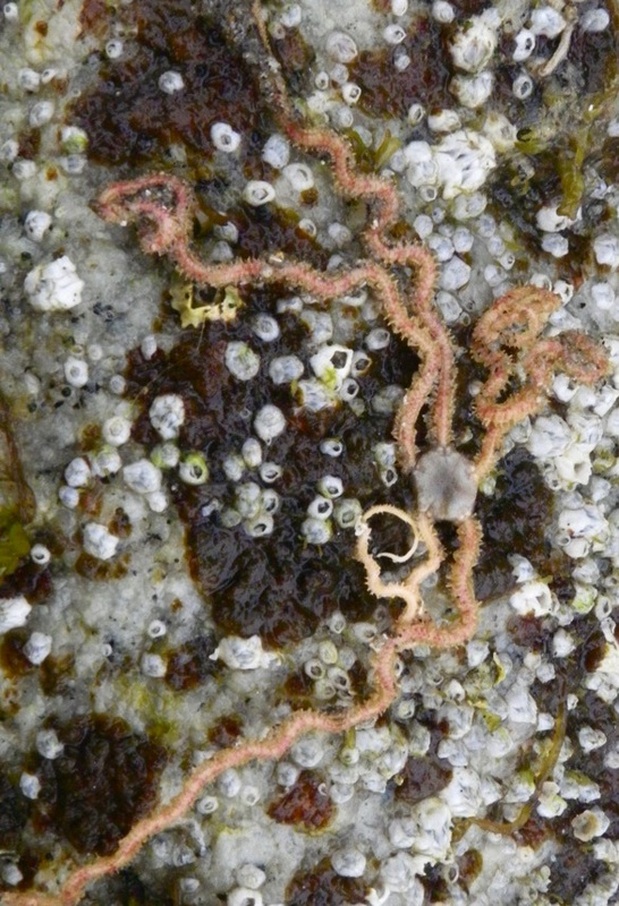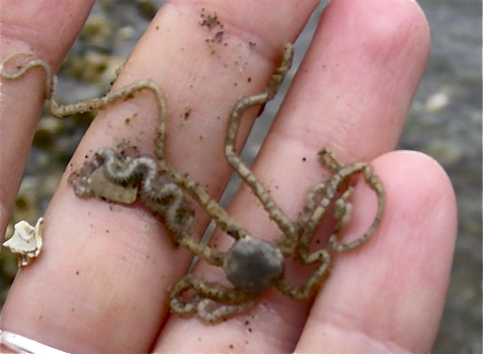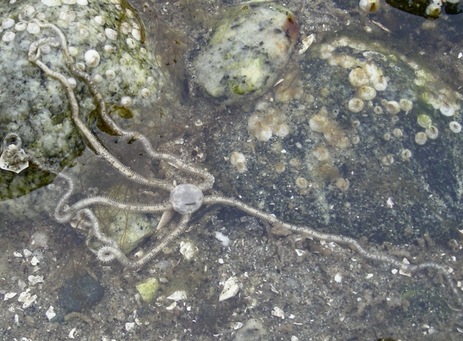Long arm brittle star, burrowing brittle star • Amphiodia periercta, A. urtica*
Long arm brittle stars found in the intertidal of Calvert Island beaches. Photos by Caylie Boos (top left) and Claire Mackenzie.
Identification
The central disc of the long arm brittle star is smooth, inflated in appearance, and has a diameter of 2 cm (3/4"). This brittle star is aptly named, as its rays can be more than 15 cm long, and will sometimes be more than 20 times the disc diameter. The plates that line the aboral side of each ray are oval-shaped, wider than they are long, and consistent in size without smaller plates in between. Three pointed spines project out from each side of each ray plate. It is yellow-brown in colour, with white or sometimes red markings. It usually occurs in high densities - up to 1500 per square metre.
Habitat & Range
The long arm brittle star is found from the intertidal zone to a depth of 1600 m (5330'). It inhabits areas with sand-mud substrate, and is one of the most common brittle stars in its habitat. Its range stretches from Baja California to Alaska.
Similar Species
The daisy brittle star (Ophiopholis aculeata) is another common species in the Pacific Northwest. Its rays only reach 9 cm (3.5") long - around half that of the long arm brittle star - and it has an obviously scalloped disc. It also has smaller plates in between larger ray plates, and its colouring is more variable and patterned.
*Recent studies suggest that A. periercta and A. urtica are the same species (Lamb and Hanby, 2005).
Intriguing Info
This species is used as a bioindicator for water quality, as it avoids areas with wastewater. Like other brittle star species it will detach then regenerate portions of its rays when disturbed or under threat, and can even detach and regenerate aboral portions of its central disc.
iNaturalist
https://www.inaturalist.org/taxa/56670-Amphiodia-occidentalis
The central disc of the long arm brittle star is smooth, inflated in appearance, and has a diameter of 2 cm (3/4"). This brittle star is aptly named, as its rays can be more than 15 cm long, and will sometimes be more than 20 times the disc diameter. The plates that line the aboral side of each ray are oval-shaped, wider than they are long, and consistent in size without smaller plates in between. Three pointed spines project out from each side of each ray plate. It is yellow-brown in colour, with white or sometimes red markings. It usually occurs in high densities - up to 1500 per square metre.
Habitat & Range
The long arm brittle star is found from the intertidal zone to a depth of 1600 m (5330'). It inhabits areas with sand-mud substrate, and is one of the most common brittle stars in its habitat. Its range stretches from Baja California to Alaska.
Similar Species
The daisy brittle star (Ophiopholis aculeata) is another common species in the Pacific Northwest. Its rays only reach 9 cm (3.5") long - around half that of the long arm brittle star - and it has an obviously scalloped disc. It also has smaller plates in between larger ray plates, and its colouring is more variable and patterned.
*Recent studies suggest that A. periercta and A. urtica are the same species (Lamb and Hanby, 2005).
Intriguing Info
This species is used as a bioindicator for water quality, as it avoids areas with wastewater. Like other brittle star species it will detach then regenerate portions of its rays when disturbed or under threat, and can even detach and regenerate aboral portions of its central disc.
iNaturalist
https://www.inaturalist.org/taxa/56670-Amphiodia-occidentalis
References
Cowles, D. (2012). Amphiodia urtica (Lyman, 1860). Invertebrates of the Salish Sea. Rosario Beach Marine Laboratory. Accessed 23/01/2014.
Harbo, R. M. (1999). Whelks to whales: Coastal marine life of the Pacific Northwest. Madeira Park, BC: Harbour Publishing. P. 138.
Lamb, A., and Hanby, B. (2005). Marine Life of the Pacific Northwest [electronic resource]. Madeira Park, BC: Harbour Publishing.
Authors and editors of page
Kelly Fretwell and Brian Starzomski (2014).
Cowles, D. (2012). Amphiodia urtica (Lyman, 1860). Invertebrates of the Salish Sea. Rosario Beach Marine Laboratory. Accessed 23/01/2014.
Harbo, R. M. (1999). Whelks to whales: Coastal marine life of the Pacific Northwest. Madeira Park, BC: Harbour Publishing. P. 138.
Lamb, A., and Hanby, B. (2005). Marine Life of the Pacific Northwest [electronic resource]. Madeira Park, BC: Harbour Publishing.
Authors and editors of page
Kelly Fretwell and Brian Starzomski (2014).







